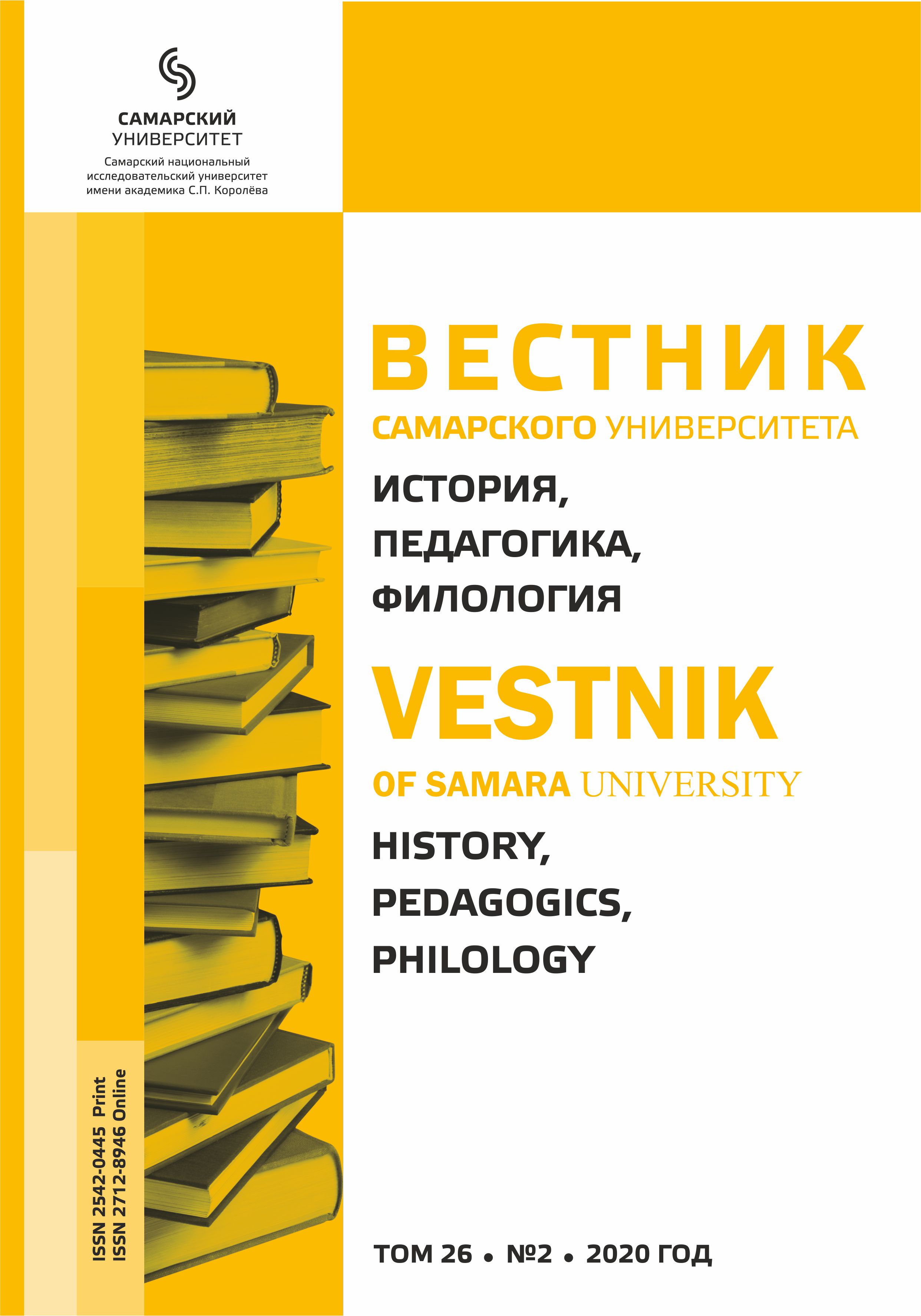Genre typology of German town chronicles of the Late Medieval and Early Modern period
- Authors: Dunaev A.E.1
-
Affiliations:
- Samara National Research University
- Issue: Vol 26, No 2 (2020)
- Pages: 154-163
- Section: Articles
- URL: https://journals.ssau.ru/hpp/article/view/7897
- DOI: https://doi.org/10.18287/2542-0445-2020-26-2-154-163
- ID: 7897
Cite item
Full Text
Abstract
In Early New High German, a realignment and enrichment of the genre system of German literature language took place. A key role belonged in this period (that is, XV and XVI centuries) to the historiography, in the first place – town chronicles. They developed, among other sources, out of the annals and other administrative writings and took their origin both in the need of upper social groups in legitimization of town structures and their general interest in history. Generally, there are two types of town chronicles, that is, official ones, which were written at the request of the town hall, and private ones. Legitimization, informing, didactic and even entertaining functions were proper to both types, but with different priority: whereas for the official chronicles, legitimization and documentation were the primary functions, for the private ones, informing and entertaining played main role. The chronicles were characterized by the syncretism and intertextuality, which means that they included charts, acts and other official documents (or their fragments) in their narrative structure. There was some difference between the authors and recipients of official chronicles, on the one hand, and these of private chronicles, on the other hand: whereas the authors of the first type were usually town scribes or highly-educated clerics, the private chronicles could also be written by ordinary citizens. Many official chronicles were initially intended for a limited circle of magistrates and not for a wide reception. For the language of town chronicles, a strong evaluative component was essential. The language of chronicles was based on the author's individual style and could vary in a wide range: from clear syntactical structures with predominance of hypotaxis and rich arsenal of stylistic means up to a plain parataxis with a simple enumeration of facts and events. Frequent use of adverbial modifiers with temporal meaning was typical. In the eyes of contemporaries, the chronicles were not exactly a genre, but rather a written history.
About the authors
A. E. Dunaev
Samara National Research University
Author for correspondence.
Email: morenov@ssau.ru
ORCID iD: 0000-0002-1593-889X
Candidate of Philological Sciences, associate professor, Department of Foreign Languages and Professional Communication
References
- Arnold 1969 – Arnold Walter (1969) Einleitung. Wormser Chronik von F. Zorn mit den Zusätzen F. von Flersheim. Hrsg. von W. Arnold. Amsterdam: Rodopi, S. 1–10. Available at: https://archive.org/details/wormserchronik00flergoog.
- Ennen 1979 – Ennen Edith (1979) Die europäische Stadt des Mittelalters. Göttingen: Vandenhoeck & Ruprecht, 331 S.
- Fleischer, Michel 1977 – Fleischer Wolfgang, Michel Georg (1977) Stilistik der deutschen Gegenwartssprache. Leipzig: Bibliographisches Institut, 394 S. Available at: http://bookre.org/reader?file=1400772.
- Grosse 1976 – Grosse Ernst (1976) Text und Kommunikation: eine linguistische Einführung in die Funktionen der Texte. Stuttgart: Kohlhammer, 164 S.
- Heinemann, Viehweger 1991 – Heinemann Wolfgang, Viehweger Dieter (1991) Textlinguistik: eine Einführung. Tübingen: Niemeyer, 310 S. doi: 10.1515/9783111376387.
- Johanek 1986 – Johanek Peter (1986) Weltchronistik und regionale Geschichtsschreibung im Spätmittelalter. In: Geschichtsschreibung und Geschichtsbewusstsein im Spätmittelalter. Hrsg. von H. Patze. Sigmaringen: Thorbecke, S. 287–330. doi: 10.11588/vuf.1987.0.16154.
- Johanek 1991 – Johanek Peter (1991) Hofhistoriograph und Stadtchronist. In: Autorentypen. Hrsg. von W. Haug [et al.]. Tübingen: Niemeyer, S. 50–68. doi: 10.1515/9783110949629-004.
- Johanek 2000 – Johanek Peter (2000) Einleitung. In: Städtische Geschichtsschreibung im Spätmittelalter und in der frühen Neuzeit. Hrsg. von P. Johanek. Köln: Böhlau, S. I–XIX.
- Klötzer 1990 – Klötzer Walter (1990) Stadtbuch. In: Handwörterbuch zur deutschen Rechtsgeschichte. Hrsg. von A. Erler und E. Kaufmann. В. IV. Berlin, Sp. 1849–1851.
- Menke 1958 – Menke Johannes (1958) Geschichtsschreibung und Politik in deutschen Städten des Mittelalters. Köln: Verlag der Löwe, 194 S. doi: 10.7788/jbkgv-1958-jg02.
- Metzler 1995 – Metzler Regine (1995) Zur Subklassifizierung chronikalischer Texte des 16. Jh. In: Chronologische, areale und situative Varietäten des Deutschen in der Sprachhistoriographie. Hrsg. von G. Lerchner. Frankfurt/Main: Peter Lang, S. 101–112.
- Polenz von 1999 – von Polenz Peter (1999) Deutsche Sprachgeschichte. Vom Spätmittelalter bis zur Gegenwart. Berlin; New York: De Gruyter. Bd. l, 380 S. doi: 10.1515/9783110314670.
- Reichmann 1996 – Reichmann Oskar (1996) Autorenintention und Textsorte. In: Textsorten im Sprachwandel, nach der Erfindung des Buchdrucks. Hg. von H. Wellmann. Heidelberg: Winter, S. 119–133.
- Schmale 1985 – Schmale Franz-Josef (1985) Funktionen und Formen mittelalterlicher Geschichtsschreibung: eine Einführung. Darmstadt: Wissenschaftliche Buchgesellschaft, 223 S.
- Schmidt 1958 – Schmidt Heinrich (1958) Die deutschen Städtechroniken als Spiegel des bürgerlichen Selbstverständnisses im späten Mittelalter. Göttingen: Vandenkoech und Ruprecht, 147 s.
- Schneider 2000 – Schneider Joachim (2000) Typologie der Nürnberger Stadtchronistik um 1500. In: Städtische Geschichtsschreibung im Spätmittelalter und in der frühen Neuzeit. Hrsg. von P. Johanek. Köln: Bohlau, S. 181–204.
- Studer 1871 – Studer Georg (1871) Einleitung. Die Berner Chronik des C. Justinger. Hrsg. von G. Studer. Bern: Verlag von K.J. Wyss, S. I–XXVII.
- Werlich 1975 – Werlich Egon (1975) Typologie der Texte. Heidelberg: Quelle & Meyer, 140 S.
- Gurevich 1999 – Gurevich A.Ja. (1999) Selected works: in 2 vol. Vol. 2: Medieval world. Categories of medieval culture. Moscow: Universitetskaya kniga, pp. 17–262. Available at: https://b-ok.cc/book/721793/7a7525. (In Russ.)
- Gukhman, Semenyuk, Babenko 1984 – Gukhman M.M., Semenyuk N.N., Babenko N.S. (1984) History of German literary language in XVI–XVIII centuries. Moscow: Nauka, 248 p. Available at: https://b-ok.cc/book/3074168/2363ff. (In Russ.)
- Dubinin 2000 – Dubinin S.I. (2000) Late-medieval German literary language: South-western region. Samara: Izd-vo «Samarskii universitet». 199 p. Available at: https://elibrary.ru/item.asp?id=30078231. (In Russ.)
- Dunaev 2020 – Dunaev A.E. (2020) Pragmatic and stylistic parameters of noun collocations in German town chronicles of the XV and XVI centuries. Vestnik of Moscow State Linguistic University. Humanities, issue 831, pp. 57–65. Available at: https://cyberleninka.ru/article/n/pragmastilisticheskie-parametry-imennyh-ustoychivyh-slovosochetaniy-v-gorodskih-hronikah-germanii-xv-xvi-vv. (In Russ.)
- Semenyuk 2000 – Semenyuk N.N. (2000) Essays on historical stylistics of German. Moscow: Institut yazykoznaniya RAN, 183 p. (In Russ.)
Supplementary files













